Taxation Law Report: Analysis of Tax Evasion, Avoidance, and Planning
VerifiedAdded on 2023/01/16
|5
|1285
|77
Report
AI Summary
This report delves into the intricacies of taxation law, focusing on the critical distinctions between tax evasion, tax avoidance, and tax planning. It begins by defining each term, highlighting the legal and ethical implications, and contrasting their objectives. Tax evasion is presented as an unlawful act aimed at reducing tax burdens through false statements, while tax avoidance is described as a legal method of minimizing tax liability by exploiting loopholes. Tax planning is positioned as a strategy to ensure tax efficiency and minimize tax burdens within the legal framework. The report then explores the judicial responses to tax avoidance and evasion, referencing key cases such as R v Mears and Keighery v Federal Commissioner of Taxation to illustrate the courts' interpretations and distinctions. It also examines how courts view aggressive tax planning and its potential illegality. The report concludes by emphasizing the importance of ethical considerations and the government's efforts to combat tax evasion, supported by relevant case law and legislation.
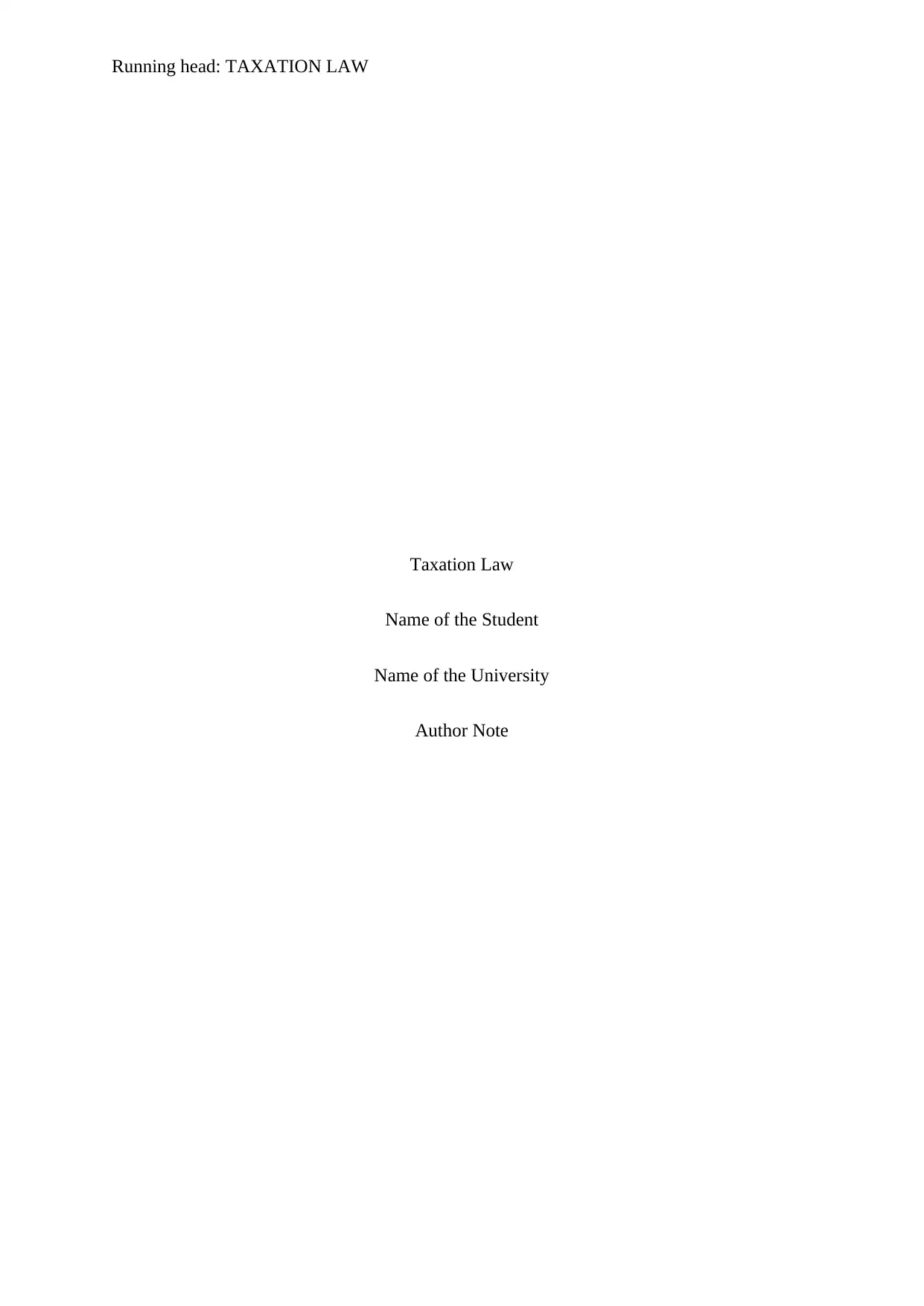
Running head: TAXATION LAW
Taxation Law
Name of the Student
Name of the University
Author Note
Taxation Law
Name of the Student
Name of the University
Author Note
Paraphrase This Document
Need a fresh take? Get an instant paraphrase of this document with our AI Paraphraser
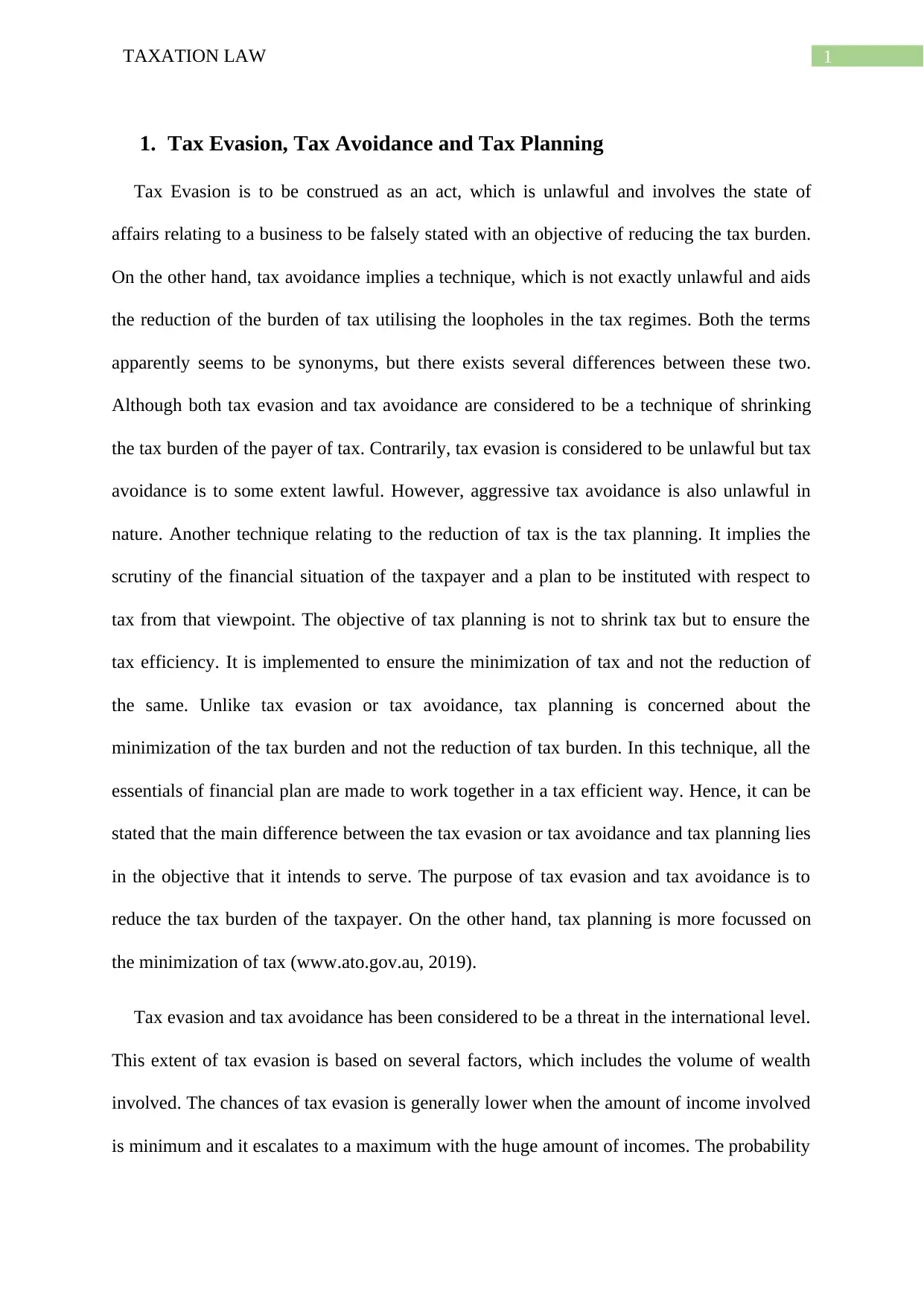
1TAXATION LAW
1. Tax Evasion, Tax Avoidance and Tax Planning
Tax Evasion is to be construed as an act, which is unlawful and involves the state of
affairs relating to a business to be falsely stated with an objective of reducing the tax burden.
On the other hand, tax avoidance implies a technique, which is not exactly unlawful and aids
the reduction of the burden of tax utilising the loopholes in the tax regimes. Both the terms
apparently seems to be synonyms, but there exists several differences between these two.
Although both tax evasion and tax avoidance are considered to be a technique of shrinking
the tax burden of the payer of tax. Contrarily, tax evasion is considered to be unlawful but tax
avoidance is to some extent lawful. However, aggressive tax avoidance is also unlawful in
nature. Another technique relating to the reduction of tax is the tax planning. It implies the
scrutiny of the financial situation of the taxpayer and a plan to be instituted with respect to
tax from that viewpoint. The objective of tax planning is not to shrink tax but to ensure the
tax efficiency. It is implemented to ensure the minimization of tax and not the reduction of
the same. Unlike tax evasion or tax avoidance, tax planning is concerned about the
minimization of the tax burden and not the reduction of tax burden. In this technique, all the
essentials of financial plan are made to work together in a tax efficient way. Hence, it can be
stated that the main difference between the tax evasion or tax avoidance and tax planning lies
in the objective that it intends to serve. The purpose of tax evasion and tax avoidance is to
reduce the tax burden of the taxpayer. On the other hand, tax planning is more focussed on
the minimization of tax (www.ato.gov.au, 2019).
Tax evasion and tax avoidance has been considered to be a threat in the international level.
This extent of tax evasion is based on several factors, which includes the volume of wealth
involved. The chances of tax evasion is generally lower when the amount of income involved
is minimum and it escalates to a maximum with the huge amount of incomes. The probability
1. Tax Evasion, Tax Avoidance and Tax Planning
Tax Evasion is to be construed as an act, which is unlawful and involves the state of
affairs relating to a business to be falsely stated with an objective of reducing the tax burden.
On the other hand, tax avoidance implies a technique, which is not exactly unlawful and aids
the reduction of the burden of tax utilising the loopholes in the tax regimes. Both the terms
apparently seems to be synonyms, but there exists several differences between these two.
Although both tax evasion and tax avoidance are considered to be a technique of shrinking
the tax burden of the payer of tax. Contrarily, tax evasion is considered to be unlawful but tax
avoidance is to some extent lawful. However, aggressive tax avoidance is also unlawful in
nature. Another technique relating to the reduction of tax is the tax planning. It implies the
scrutiny of the financial situation of the taxpayer and a plan to be instituted with respect to
tax from that viewpoint. The objective of tax planning is not to shrink tax but to ensure the
tax efficiency. It is implemented to ensure the minimization of tax and not the reduction of
the same. Unlike tax evasion or tax avoidance, tax planning is concerned about the
minimization of the tax burden and not the reduction of tax burden. In this technique, all the
essentials of financial plan are made to work together in a tax efficient way. Hence, it can be
stated that the main difference between the tax evasion or tax avoidance and tax planning lies
in the objective that it intends to serve. The purpose of tax evasion and tax avoidance is to
reduce the tax burden of the taxpayer. On the other hand, tax planning is more focussed on
the minimization of tax (www.ato.gov.au, 2019).
Tax evasion and tax avoidance has been considered to be a threat in the international level.
This extent of tax evasion is based on several factors, which includes the volume of wealth
involved. The chances of tax evasion is generally lower when the amount of income involved
is minimum and it escalates to a maximum with the huge amount of incomes. The probability
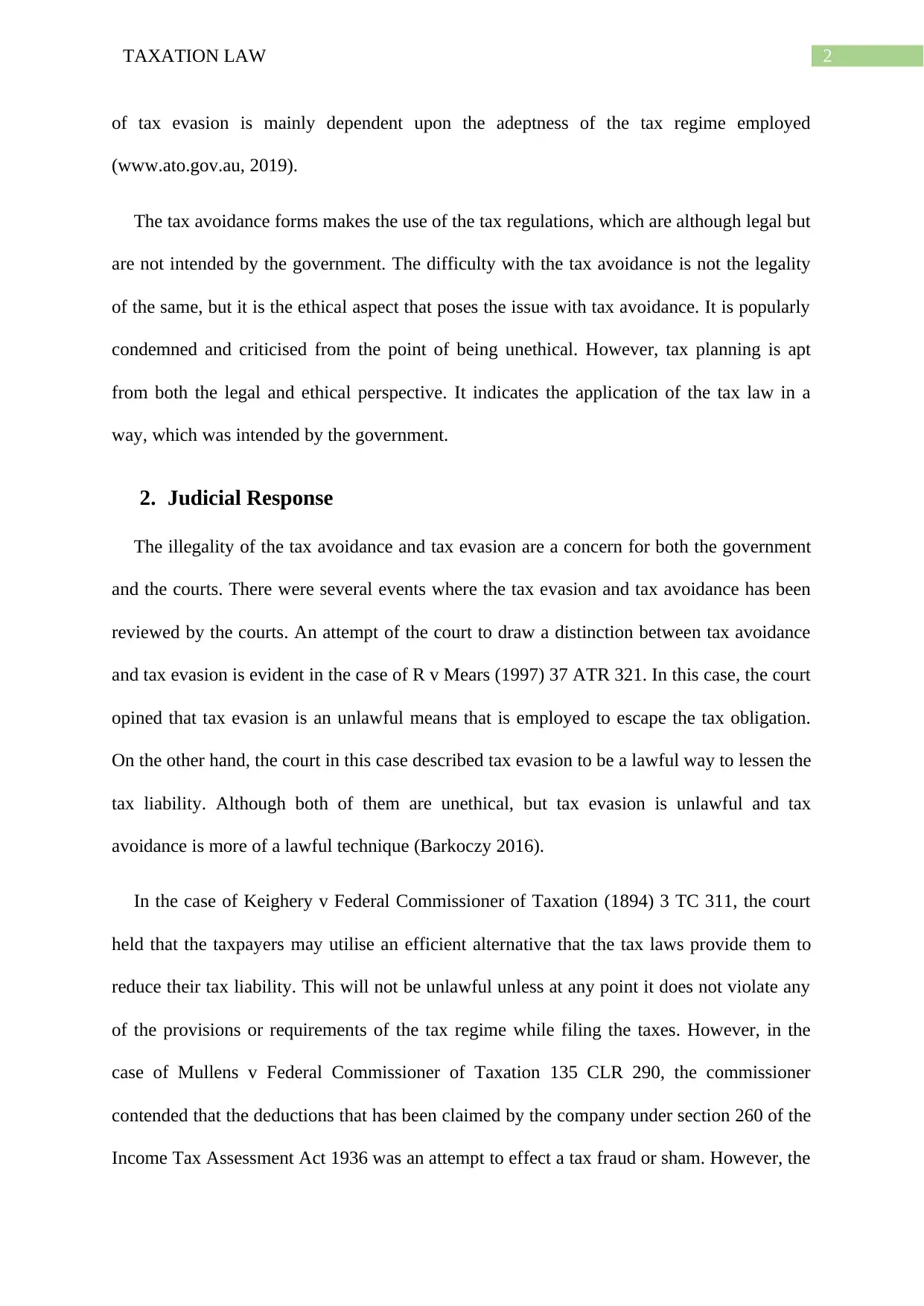
2TAXATION LAW
of tax evasion is mainly dependent upon the adeptness of the tax regime employed
(www.ato.gov.au, 2019).
The tax avoidance forms makes the use of the tax regulations, which are although legal but
are not intended by the government. The difficulty with the tax avoidance is not the legality
of the same, but it is the ethical aspect that poses the issue with tax avoidance. It is popularly
condemned and criticised from the point of being unethical. However, tax planning is apt
from both the legal and ethical perspective. It indicates the application of the tax law in a
way, which was intended by the government.
2. Judicial Response
The illegality of the tax avoidance and tax evasion are a concern for both the government
and the courts. There were several events where the tax evasion and tax avoidance has been
reviewed by the courts. An attempt of the court to draw a distinction between tax avoidance
and tax evasion is evident in the case of R v Mears (1997) 37 ATR 321. In this case, the court
opined that tax evasion is an unlawful means that is employed to escape the tax obligation.
On the other hand, the court in this case described tax evasion to be a lawful way to lessen the
tax liability. Although both of them are unethical, but tax evasion is unlawful and tax
avoidance is more of a lawful technique (Barkoczy 2016).
In the case of Keighery v Federal Commissioner of Taxation (1894) 3 TC 311, the court
held that the taxpayers may utilise an efficient alternative that the tax laws provide them to
reduce their tax liability. This will not be unlawful unless at any point it does not violate any
of the provisions or requirements of the tax regime while filing the taxes. However, in the
case of Mullens v Federal Commissioner of Taxation 135 CLR 290, the commissioner
contended that the deductions that has been claimed by the company under section 260 of the
Income Tax Assessment Act 1936 was an attempt to effect a tax fraud or sham. However, the
of tax evasion is mainly dependent upon the adeptness of the tax regime employed
(www.ato.gov.au, 2019).
The tax avoidance forms makes the use of the tax regulations, which are although legal but
are not intended by the government. The difficulty with the tax avoidance is not the legality
of the same, but it is the ethical aspect that poses the issue with tax avoidance. It is popularly
condemned and criticised from the point of being unethical. However, tax planning is apt
from both the legal and ethical perspective. It indicates the application of the tax law in a
way, which was intended by the government.
2. Judicial Response
The illegality of the tax avoidance and tax evasion are a concern for both the government
and the courts. There were several events where the tax evasion and tax avoidance has been
reviewed by the courts. An attempt of the court to draw a distinction between tax avoidance
and tax evasion is evident in the case of R v Mears (1997) 37 ATR 321. In this case, the court
opined that tax evasion is an unlawful means that is employed to escape the tax obligation.
On the other hand, the court in this case described tax evasion to be a lawful way to lessen the
tax liability. Although both of them are unethical, but tax evasion is unlawful and tax
avoidance is more of a lawful technique (Barkoczy 2016).
In the case of Keighery v Federal Commissioner of Taxation (1894) 3 TC 311, the court
held that the taxpayers may utilise an efficient alternative that the tax laws provide them to
reduce their tax liability. This will not be unlawful unless at any point it does not violate any
of the provisions or requirements of the tax regime while filing the taxes. However, in the
case of Mullens v Federal Commissioner of Taxation 135 CLR 290, the commissioner
contended that the deductions that has been claimed by the company under section 260 of the
Income Tax Assessment Act 1936 was an attempt to effect a tax fraud or sham. However, the
⊘ This is a preview!⊘
Do you want full access?
Subscribe today to unlock all pages.

Trusted by 1+ million students worldwide
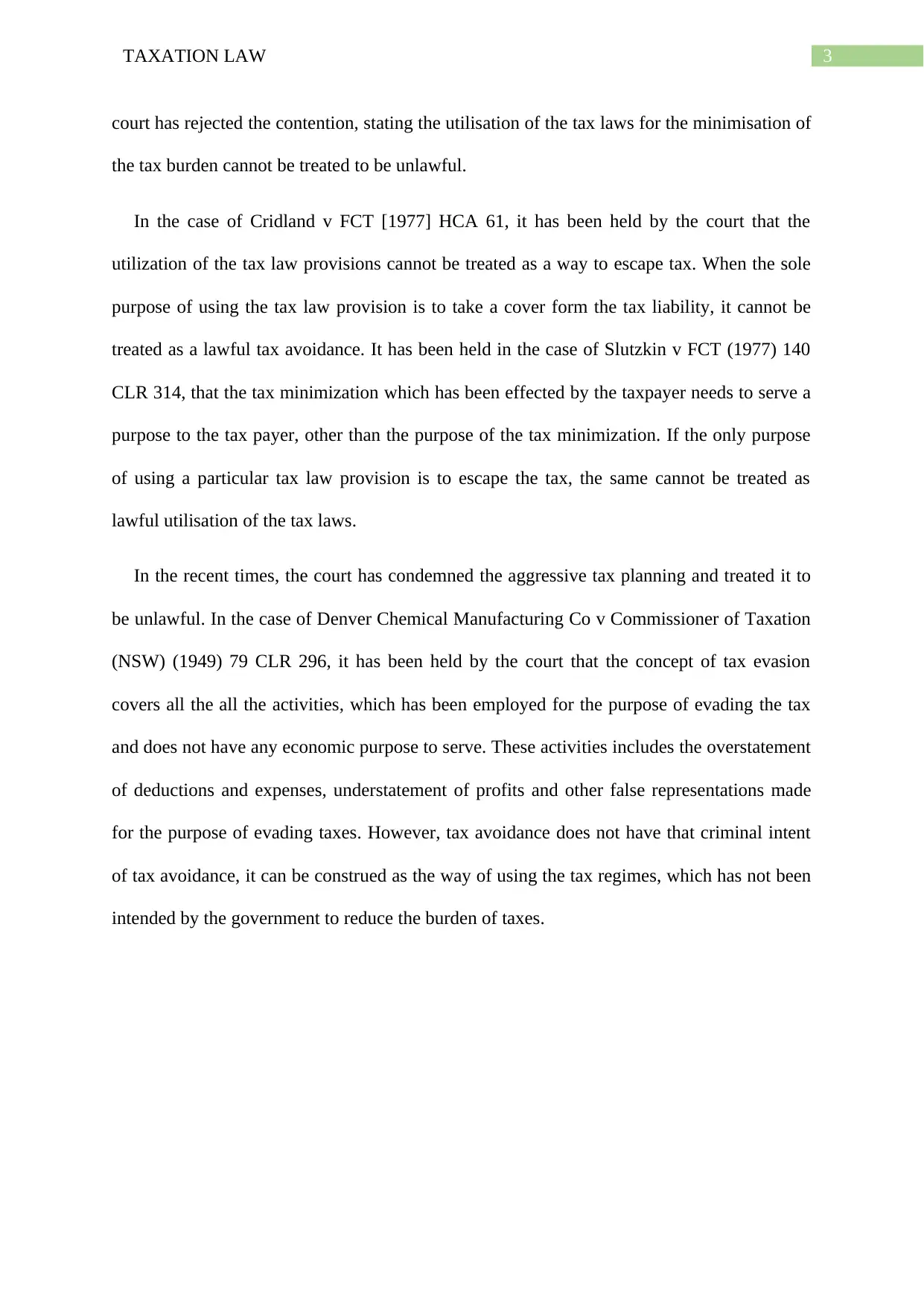
3TAXATION LAW
court has rejected the contention, stating the utilisation of the tax laws for the minimisation of
the tax burden cannot be treated to be unlawful.
In the case of Cridland v FCT [1977] HCA 61, it has been held by the court that the
utilization of the tax law provisions cannot be treated as a way to escape tax. When the sole
purpose of using the tax law provision is to take a cover form the tax liability, it cannot be
treated as a lawful tax avoidance. It has been held in the case of Slutzkin v FCT (1977) 140
CLR 314, that the tax minimization which has been effected by the taxpayer needs to serve a
purpose to the tax payer, other than the purpose of the tax minimization. If the only purpose
of using a particular tax law provision is to escape the tax, the same cannot be treated as
lawful utilisation of the tax laws.
In the recent times, the court has condemned the aggressive tax planning and treated it to
be unlawful. In the case of Denver Chemical Manufacturing Co v Commissioner of Taxation
(NSW) (1949) 79 CLR 296, it has been held by the court that the concept of tax evasion
covers all the all the activities, which has been employed for the purpose of evading the tax
and does not have any economic purpose to serve. These activities includes the overstatement
of deductions and expenses, understatement of profits and other false representations made
for the purpose of evading taxes. However, tax avoidance does not have that criminal intent
of tax avoidance, it can be construed as the way of using the tax regimes, which has not been
intended by the government to reduce the burden of taxes.
court has rejected the contention, stating the utilisation of the tax laws for the minimisation of
the tax burden cannot be treated to be unlawful.
In the case of Cridland v FCT [1977] HCA 61, it has been held by the court that the
utilization of the tax law provisions cannot be treated as a way to escape tax. When the sole
purpose of using the tax law provision is to take a cover form the tax liability, it cannot be
treated as a lawful tax avoidance. It has been held in the case of Slutzkin v FCT (1977) 140
CLR 314, that the tax minimization which has been effected by the taxpayer needs to serve a
purpose to the tax payer, other than the purpose of the tax minimization. If the only purpose
of using a particular tax law provision is to escape the tax, the same cannot be treated as
lawful utilisation of the tax laws.
In the recent times, the court has condemned the aggressive tax planning and treated it to
be unlawful. In the case of Denver Chemical Manufacturing Co v Commissioner of Taxation
(NSW) (1949) 79 CLR 296, it has been held by the court that the concept of tax evasion
covers all the all the activities, which has been employed for the purpose of evading the tax
and does not have any economic purpose to serve. These activities includes the overstatement
of deductions and expenses, understatement of profits and other false representations made
for the purpose of evading taxes. However, tax avoidance does not have that criminal intent
of tax avoidance, it can be construed as the way of using the tax regimes, which has not been
intended by the government to reduce the burden of taxes.
Paraphrase This Document
Need a fresh take? Get an instant paraphrase of this document with our AI Paraphraser
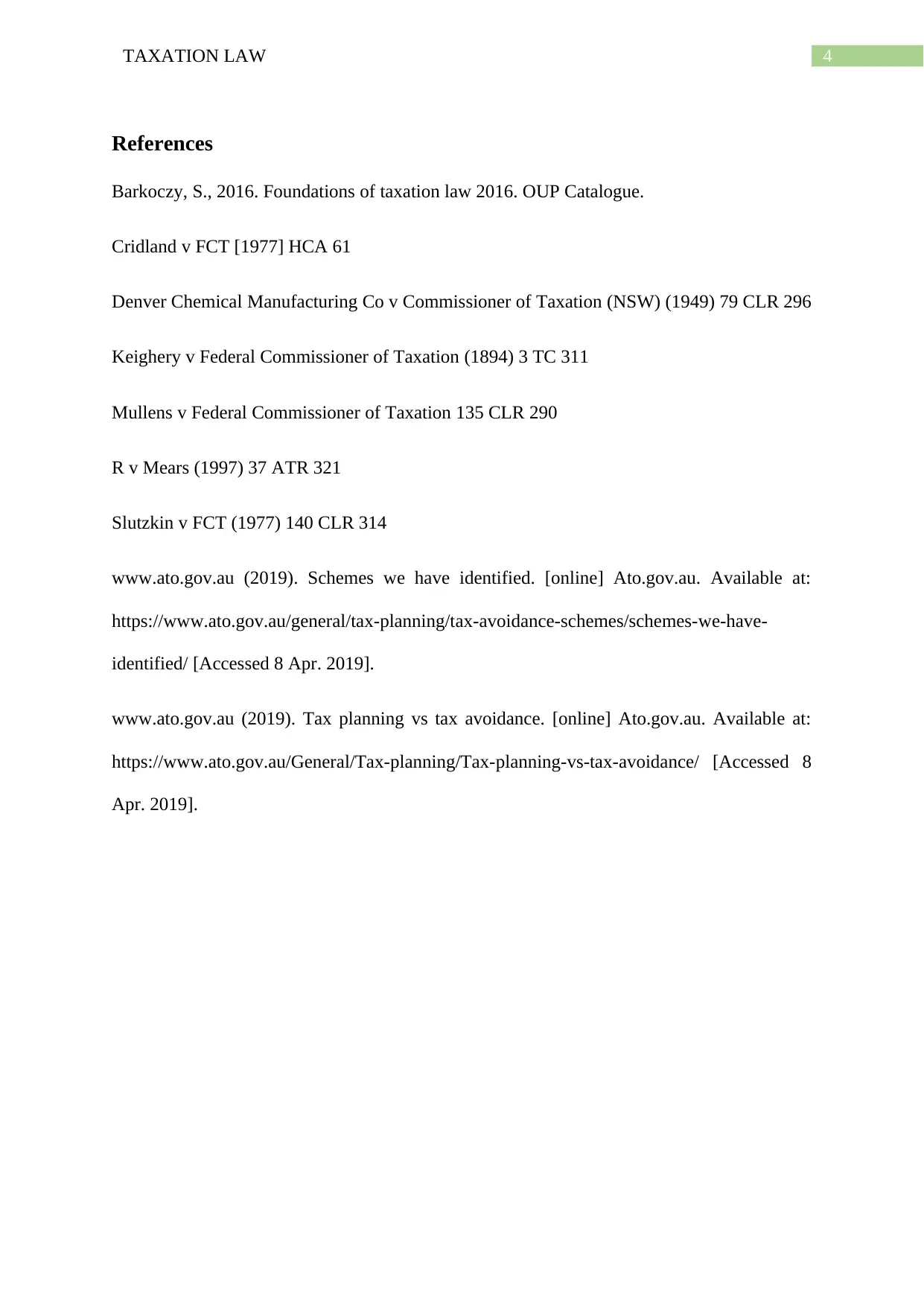
4TAXATION LAW
References
Barkoczy, S., 2016. Foundations of taxation law 2016. OUP Catalogue.
Cridland v FCT [1977] HCA 61
Denver Chemical Manufacturing Co v Commissioner of Taxation (NSW) (1949) 79 CLR 296
Keighery v Federal Commissioner of Taxation (1894) 3 TC 311
Mullens v Federal Commissioner of Taxation 135 CLR 290
R v Mears (1997) 37 ATR 321
Slutzkin v FCT (1977) 140 CLR 314
www.ato.gov.au (2019). Schemes we have identified. [online] Ato.gov.au. Available at:
https://www.ato.gov.au/general/tax-planning/tax-avoidance-schemes/schemes-we-have-
identified/ [Accessed 8 Apr. 2019].
www.ato.gov.au (2019). Tax planning vs tax avoidance. [online] Ato.gov.au. Available at:
https://www.ato.gov.au/General/Tax-planning/Tax-planning-vs-tax-avoidance/ [Accessed 8
Apr. 2019].
References
Barkoczy, S., 2016. Foundations of taxation law 2016. OUP Catalogue.
Cridland v FCT [1977] HCA 61
Denver Chemical Manufacturing Co v Commissioner of Taxation (NSW) (1949) 79 CLR 296
Keighery v Federal Commissioner of Taxation (1894) 3 TC 311
Mullens v Federal Commissioner of Taxation 135 CLR 290
R v Mears (1997) 37 ATR 321
Slutzkin v FCT (1977) 140 CLR 314
www.ato.gov.au (2019). Schemes we have identified. [online] Ato.gov.au. Available at:
https://www.ato.gov.au/general/tax-planning/tax-avoidance-schemes/schemes-we-have-
identified/ [Accessed 8 Apr. 2019].
www.ato.gov.au (2019). Tax planning vs tax avoidance. [online] Ato.gov.au. Available at:
https://www.ato.gov.au/General/Tax-planning/Tax-planning-vs-tax-avoidance/ [Accessed 8
Apr. 2019].
1 out of 5
Related Documents
Your All-in-One AI-Powered Toolkit for Academic Success.
+13062052269
info@desklib.com
Available 24*7 on WhatsApp / Email
![[object Object]](/_next/static/media/star-bottom.7253800d.svg)
Unlock your academic potential
Copyright © 2020–2025 A2Z Services. All Rights Reserved. Developed and managed by ZUCOL.





